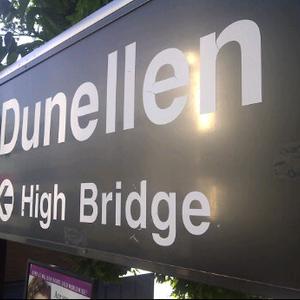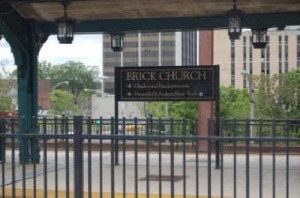New Jersey Future Blog
Dunellen and East Orange as Transit Villages: One Designation, Two Strategies
August 29th, 2012 by Elaine Clisham
 On Aug. 27, the neighborhoods around the Dunellen train station and the Brick Church station in East Orange became the 25th and 26th areas to receive Transit Village designation from the state Department of Transportation, something that gets them some DOT grant money and a higher place in line for funds from the program’s partner agencies. While the designation is the same, the development strategies in each municipality are very different. For one municipality the designation is intended to spark higher-density residential development, and for the other it is directed toward commercial and employment revitalization.
On Aug. 27, the neighborhoods around the Dunellen train station and the Brick Church station in East Orange became the 25th and 26th areas to receive Transit Village designation from the state Department of Transportation, something that gets them some DOT grant money and a higher place in line for funds from the program’s partner agencies. While the designation is the same, the development strategies in each municipality are very different. For one municipality the designation is intended to spark higher-density residential development, and for the other it is directed toward commercial and employment revitalization.
According to a New Jersey Future analysis of transit stations and their surrounding neighborhoods, the two municipalities share very little in terms of transit-related characteristics:
| Feature | Median of all Transit Neighborhoods |
Dunellen | East Orange/ Brick Church |
|---|---|---|---|
| Population density | 4,353/sq. mi. | 3,821/sq. mi. | 14,719/sq. mi. |
| Station-area parking spaces per 1,000 residents |
11.9 | 7.8 | .07 |
| Parking usage rate | 108.7% | 110.4% | |
| Housing density | 1,693 units/sq. mi. | 1,320 units/sq. mi. | 6,711 units/sq. mi. |
| Vehicle ownership per household |
1.69 | 1.84 | 0.95 |
| Transit commuting rate | 10.8% of commuters | 8.0% of commuters | 22.9% of commuters |
| Median HH income | $74,188 | $74,990 | $38,621 |
Dunellen: Anticipating Ridership Growth
 As the figures in the table suggest, there is a lot of opportunity for Dunellen to increase residential development around its transit-related assets. Even among those who live closest to the station, fewer residents commute by train than in transit neighborhoods in other municipalities. The stress placed on adjacent parking may be one reason Dunellen commuters opt for other modes of travel than the train.
As the figures in the table suggest, there is a lot of opportunity for Dunellen to increase residential development around its transit-related assets. Even among those who live closest to the station, fewer residents commute by train than in transit neighborhoods in other municipalities. The stress placed on adjacent parking may be one reason Dunellen commuters opt for other modes of travel than the train.
Until recently another suppressor of transit ridership from Dunellen (and from its fellow Raritan Valley line stations) was the fact that its rail line is not electrified, requiring passengers to change trains in Newark to reach New York City. However, NJ Transit has recently put into service several new dual-mode locomotives, which can operate under either diesel or electric power, meaning that, when they are deployed on the Raritan Valley Line, passengers will for the first time have access to a faster and more convenient one-seat ride directly into New York Penn Station. Weekday boardings along this line should only increase.
Securing its Transit Village designation in anticipation of better transit service should give Dunellen the opportunity to spark residentially-focused mixed-use development, including redevelopment of the old Art Color Printing site.
Brick Church: Seeking Commercial Revitalization
 By contrast, the Brick Church station neighborhood in East Orange already has high residential densities, but it’s an area of less affluence, with much lower rates of automobile ownership (although just as much stress on its adjacent parking), and hence much higher transit dependency. According to a 2006 summary of its master plan (pdf), the municipality intends to use its Transit Village designation to spur commercial development and job growth near the station.
By contrast, the Brick Church station neighborhood in East Orange already has high residential densities, but it’s an area of less affluence, with much lower rates of automobile ownership (although just as much stress on its adjacent parking), and hence much higher transit dependency. According to a 2006 summary of its master plan (pdf), the municipality intends to use its Transit Village designation to spur commercial development and job growth near the station.
The contrast between these strategies is a testament to the adaptability of the Transit Village program. Each municipality is able to use the designation in a way that best serves its residents – in Dunellen, by increasing residential growth (and, presumably, residential values) near a station that should be starting to see higher ridership rates, and in East Orange, by expanding employment opportunities for its residents and building its commercial tax base. It’s encouraging to see $1 million in funding for Transit Villages restored in DOT’s 2013 draft capital program, and as planning begins for the 2014 capital program we hope that funding will be maintained or increased. As we’ve said before, in terms of the different ways it can be leveraged and the range of benefits it can engender, it seems like money well spent.
New Jersey Future will soon release a full report detailing its analysis of development assets around transit. Sign up here to be notified when the report is published.

















Why has NJ Transit not replaced all diesel units with dual-purpose engines along Raritan Valley line? Skipping Newark would improve the economy dramatically for every town along the line. It would also vastly improve the lives of every commuter. TC